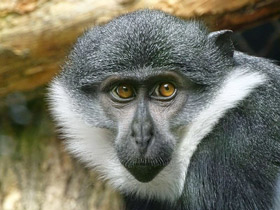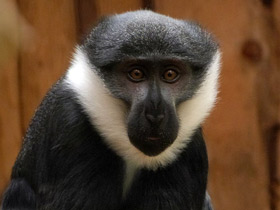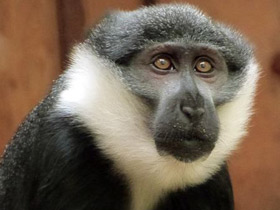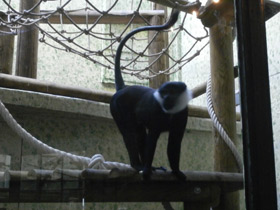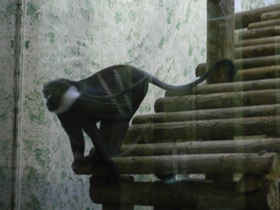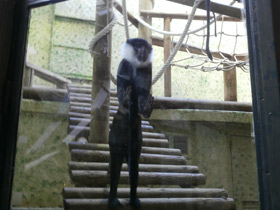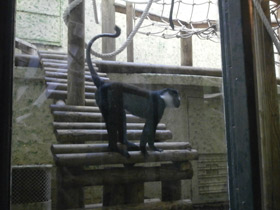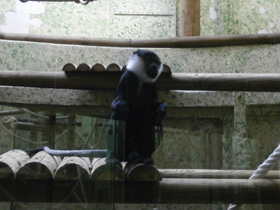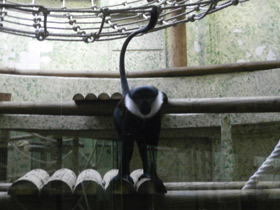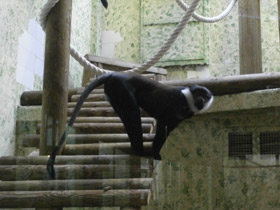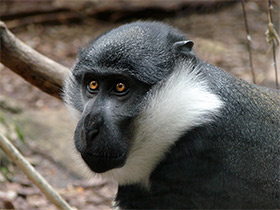L'Hoest's monkey (Allochrocebus lhoesti), the mountain monkey
L'Hoest's monkey (Allochrocebus lhoesti), also known as the mountain monkey, is a guenon found in the upper eastern Congo basin. They mostly live in mountainous forest areas in small, female-dominated groups. They have a dark coat and can be distinguished by a characteristic white beard.
Taxonomy
It was Philip Lutley Sclater who originally gave the specific name Cercopithecus lhoesti in honor of François L'Hoëst, director of the Antwerp Zoo, in 1898.
L'Hoest's monkey is currently classified as a member of the genus Allochrocebus. Formerly, L'Hoest's monkey included the taxon preussi from the Gulf of Guinea region as a subspecies, but it is now considered a separate species, Preuss's monkey (Allochrocebus preussi).
L'Hoest's monkey was formerly included in the genus Cercopithecus. Molecular studies published by Anthony Tosi in 2003 had raised doubts about the classification of L'Hoest's monkey as a member of the genus Cercopithecus. The studies indicated that L'Hoest's monkey (along with the others in its species group) is more closely related to the vervet monkeys of the genus Chlorocebus and the patas monkey (genus Erythrocebus) than to the other guenons of the genus Cercopithecus.
Habitat area
Cercopithecus lhoesti is a species of catarrhine primate of the family Cercopithecidae. Cercopithecus lhoesti is found in the eastern Congo Basin, Burundi, Uganda, Rwanda and Zaire. Habitat of Cercopithecus lhoesti: wetlands, uplands and rainforest at altitudes up to 2,500m.
They have also been found in isolated patches of forest vegetation among mountain meadows. Cercopithecus lhoesti prefers mature, moist, tall primary forests; it is also found in gallery and secondary forests, with dense undergrowth. Although Cercopithecus lhoesti is a forest monkey, it also occurs in wooded savannah and at the edge of wooded areas; it also occurs in cultivated land.
Appearance
This monkey has a body length of 46-56 cm and a tail of 42-68 cm, and males weigh up to 7.5 kg and females about 4.5 kg. Its coat is dark grey, brown or chestnut, with a white undercoat.
Nutrition
Their diet is based on a mixed diet of fruits, flowers, shoots, seeds, roots and succulents, eggs, insects, small lizards and even birds. Fruits usually account for about 47% of their diet, 24% is terrestrial herbaceous vegetation and other foods account for 35%. The proportion of a particular food in the diet is usually determined by its availability and abundance. When the proportion of fruit decreases, the amount of insects and other invertebrates consumed increases. The duration of daily foraging routes also depends on food abundance.
Lifestyle
Cercopithecus lhoesti are arboreal and diurnal animals. They sleep in trees, in a sitting position, clinging to branches or each other. These monkeys are most active in the early morning; around midday, after feeding in the morning and during the hottest part of the day, they take refuge in the treetops. Cercopithecus lhoesti forage mainly on the ground, but in case of danger they try to hide in dense canopy vegetation.
Social behaviour and reproduction
Cercopithecus lhoesti live in family groups of 5 to 25 individuals, usually including a male, several mature females and their offspring of different ages. It has been observed that if the group is threatened, the females are often the most aggressive members of the group, acting to defend it. The gestation period of Cercopithecus lhoesti is about 5 months (or 135-200 days). The birth of young usually occurs at the end of the dry season, when the rains begin to fall. The female gives birth to a calf, usually at night. Immediately after giving birth, she eats the placenta and carefully licks the calf, which is firmly attached to her fur on her belly. The young usually remain with their mother until their next birth, which lasts about two years. Young Cercopithecus lhoesti have grasping tails strong enough to support their weight. This feature is exceptional for Old World monkeys. However, as they grow older, Cercopithecus lhoesti lose this ability and use their tails only for balance during movement and jumping. Young males usually leave the group, while females remain in the maternal group permanently.

















